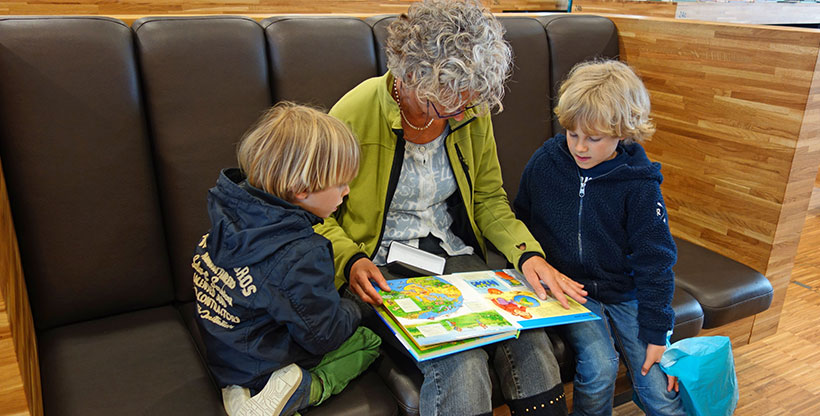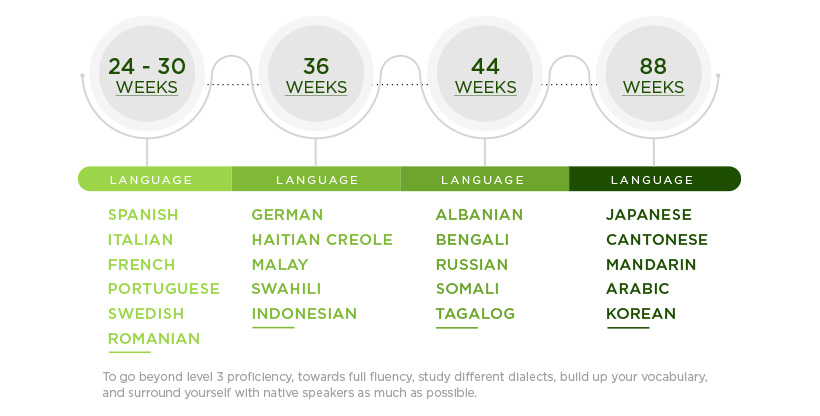Individuals
Using Learning Styles to Help Expats Learn a New Language Quickly

Learning a second language quickly and efficiently is especially important for expats, and research suggests that learning in accordance with your strengths and preferences can help individuals memorize and retain information more easily.
This guide will help you identify your learning style and advise you on how to apply it. Because expats are immersed in the language and culture, their learning landscape is different than the average student, and our advice is tailored to help expats leverage their environment to learn quickly. We will also provide timeframes to set realistic expectations.
In This Guide You’ll Learn:
Learning styles were developed with the recognition that learning is not a one-size-fits-all process. While one person may enjoy traditional classroom learning, another may find it aggravating to sit at a desk. Learning styles are also a good common-sense approach since a method that interests you is more likely to yield consistency over one that feels boring or tedious.
Learning a language is just one step of the expat journey. For more helpful guidance on getting visas, moving to another country, the role of your embassy, and more, check out our resource for expats.
What are the Benefits of Learning a Language?
Learning a second language has its obvious benefits. As an expat, you can more easily navigate your new country and perform everyday tasks like ordering off a menu and giving directions to a driver. Other benefits include:
- Building connections: Even a shaky attempt at speaking the local language indicates a willingness to try and can build relationships.
- Helping with adjustment: Language can sometimes mitigate culture shock, helping you feel like a part of your environment instead of apart.
- Self-sufficiency: In some parts of the world, English may not be widely spoken. If you’re unable to use technology, such as Google Translate, to close the communication gaps, this can put expats in a difficult position.
- Professional advantages: Speaking your host country’s language can help fulfill responsibilities at work and adapt to the workplace. And for those seeking a new job, bilingual candidates have a significant advantage. Language Testing International reported statistics that illustrate the demand for bilingual candidates, stating the need has “more than doubled between 2010 and 2015, and since 2020, there has been a 30% increase in bilingual remote jobs.”
In addition to improving the practical aspects of life, learning a language also has many brain health benefits including:
- Improving Overall Learning and Memory: A study at Lund University found that learning a new language can trigger the hippocampus to grow, a part of the brain crucial to learning and memory.
- Minimizing the effects of aging: Research published in the Annals of Neurology states that bilinguals typically retain their cognitive function as they age, and it helps delay the onset of dementia.
- Improving mental processing: According to research from Northwestern University, “bilingual brains [are] better equipped to process information,” so knowing a second language can make you a better thinker overall.
How Expats Can Use Learning Styles to Learn a Foreign Language
Learning styles began developing as early as 1905, with the advent of the IQ test, which highlighted individual differences. Learning styles were slowly developed over the decades with the intention of optimizing education, based on observations made by various education professionals.
In 1992, Neil Fleming and Colleen Mills of Lincoln University in New Zealand published research coining the VARK model. It states that there are four primary types of learning styles:
- Visual
- Auditory
- Reading and writing
- Kinesthetic
VARK has remained popular throughout the decades since it is fairly intuitive and easy to adapt for both learners and teachers.
There is ongoing debate about the validity of learning styles, including VARK. Some theorists claim there is little to no evidence to support its effectiveness, such as this 2020 research from Richard M. Felder at North Carolina State University. However, contrary research exists too, such as that published in the June 2022 issue of Journal of Medicine and Family Care which suggests a “correlation between learning style and academic performance.”
While the topic is debated, it stands to reason that the VARK model is a sensible approach to learning a language since activities that align with your preferences will help you stay interested and engaged. Compatible learning styles can also pique your interest in learning, which is important because, as Edutopia discusses, studies show curiosity prepares the brain to learn and puts it in the best state to retain information.
“[W]e’re more likely to remember what we’ve learned when the subject matter intrigues us,”
according to Edutopia, a foundation for better learning
To successfully master a second language, you will have to eventually study it in all its forms, written and spoken, but it’s important to first build a strong foundation through consistent study. The sections below detail characteristics of each type of learner, general tips, and advice for how expats can take advantage of their new environment to learn faster.
Visual Learning
Characteristics
Bay Atlantic University notes that visual learners are typically alert and detail-oriented, with a tendency to take stock of their surroundings. They might recall things they saw more quickly than others, like details of their childhood bedroom. These learners remember images clearly and understand best through visual means, such as:
- Photographs
- Charts
- Videos
- Graphs
- Diagrams
- Slideshows
- Maps
Rather than understanding through reading or listening, these individuals often understand information more easily through visual means. For example, visual learners may struggle to comprehend a medical diagnosis until it’s explained using a plastic anatomical model, a drawing, or other visual assistance.
How to Use Visual Learning
Add a visual aspect to studying. Use visual devices to remember vocabulary words and new alphabet systems. This is commonly used in children’s classrooms. For example, the letter S may be drawn with a snake to help children associate the sound with the letter.
Visual devices are useful for adults, too. Emmy award-winning teacher Dr. Tim Cook teaches Japanese using such devices. One example is the character for the sound “no,” which is drawn as の. In his videos, he overlays the no smoking sign over the Japanese character to help students remember the association.
Try using a language learning app that is tailored to visual learners, such as Drop, which teaches using images and matching games.
Expats who are visual learners can benefit from exploring their environment. Signs are a good way to pick up on words, as many of them are universal and easy to interpret, like stop signs. If you’re unsure of a meaning, you can look up the meaning once and learn through visual repetition.
It may be beneficial to catch a movie at your local theater and actively compare the captions to the spoken words. Visual learners are especially skilled at reading body language, so the physical expression of vocabulary words will likely help you remember them as well. You can also browse local libraries and bookstores to find books with vivid visual elements, like illustrated children’s books or photography-heavy books.

Auditory Learning
Characteristics
Auditory learners prefer to hear information. This might be your style if you can follow step-by-step instructions from a math teacher without looking up to watch the instructor perform the equation. According to Western Governors University, auditory learners are often talented storytellers and public speakers, as verbal communication is a strength. These learners also work well in groups and excel in lecture-based classes.
How to Use Auditory Learning
Good news for auditory learners! Full immersion into the language can speed up your learning process. However, audial learning isn’t just about listening; it also includes speaking. Practice makes perfect, so seek out opportunities to practice your conversational skills as often as possible. Join a conversation group or find one-on-one lessons.

English teacher Hannah Pearson shared her experience on British Council, a website for culture relations. On her first trip overseas to Spain, she learned very little Spanish after sticking close to English speakers the six months she was there. “In terms of improving my Spanish, I did it wrong,” she says. Pearson later took another position in Mexico and changed her habits to incorporate more Spanish into her life. She advises expats to live with native speakers, if possible, say “yes” when invited, and insist on practicing Spanish.
“Be consistent and continue to speak the local language, even if your replies keep coming in English,”
Hannah Pearson, English teacher
Like visual learners, auditory learners can benefit from a visit to the movie theater or from watching local television shows, especially children’s shows, many of which are designed for the early stages of learning. Try podcasts on topics that interest you or listen to audiobooks in your target language, beginning with less complex material, like children’s and young adult books. Listening to music may also help you understand the flow of the language and interpret emotions associated with specific phrases.
To learn through an app, consider Rosetta Stone which has audio recognition capabilities and allows students to read along with native speakers, or try Babbel, which has interactive dialogue.
Learning Through Reading and Writing
If you enjoy learning in a traditional classroom setting, this is likely your learning style. These individuals thrive from text learning which includes reading textbooks, taking notes, writing papers, and studying written texts. Vark-learn.com states that these types of individuals are prone to list-making, may use difficult vocabulary words, and enjoy challenging rules and regulations because of their wording.

How to Use Reading and Writing for Learning
Fortunately, most classroom materials are friendly to reading and writing learners. Expats should research classes in their area or, if unavailable, online. Try leafing through study guides, phrase books, slideshows, and doing writing prompts.
Reading and writing learners might also appreciate online language challenges, websites, and mobile apps. Goal-oriented apps, such as Busuu, have a more expansive vocabulary and may appeal to these individuals.
Try making small adjustments in your daily routine to incorporate more practice, like making grocery lists in your new language or switching your phone’s language. If you have colleagues or classmates also learning, you might practice messaging each other in your new language.
Reading and writing learners, like the styles above, can also benefit from simple texts, like children’s books. However, they may enjoy the challenge of more complex text right away. These learners may find it fun to dissect books in their target language, line by line, to see verb conjugation, idioms, and other language concepts in action.
Expats who enjoy learning through reading and writing should search for language classes nearby. Learning in-person will also help you build local connections. You may also seek out individuals with similar interests, like poetry or a book club, to help you engage with text. According to the educational website, Techboomers, the social platform, Meetup.com, organizes gatherings in “over 179 countries [with] 610,000 monthly meetups tak[ing] place.”
It may also be helpful to filter your surroundings through text to help you learn new sets of vocabulary words. A visit to a museum will yield different vocabulary knowledge than a visit to a garden. Carry a notebook or use a note application on your phone to document interesting things and paraphrase experiences in your target language.
Kinesthetic Learning
These individuals prefer to use their hands and bodies to execute a task rather than reading a textbook or listening to a lecture. If you sit through a tutorial eager to try something for yourself, this might be your learning style. These learners appreciate examples and activities and typically like to try things before they fully understand them, using their mistakes to improve their abilities.

Kinesthetic learners might also benefit from muscle memory, meaning physical activity helps them retain information, as found by the study published on The American Journal of Surgery website. A 2019 study titled “Words in Motion: Kinesthetic Language Learning in Virtual Reality” supported this theory. Researchers used actions in virtual reality to teach words, and positive results were reported. The more times a word was paired with an action, the more it was remembered by the subjects.
How to Use Kinesthetic Learning
Engage your body while studying. The language app Pimsleur was designed to be used on the go, enabling you to learn while walking, running, lifting weights, etc. Their view on language learning is that you’ve never “seen a toddler memorizing vocabulary lists.”
Try playing video, board, or role-laying games. Use Meetup.com to connect with others you can engage with and learn from or along with. In addition to learning the language, you will make connections and help stave off isolation and culture shock.
For kinesthetic learners, environment can be as important as movement. The language experts at Rocket Languages note that the right surroundings help process information, so even if you’re studying solo, try doing it out in the community.
Levels of Language Fluency
There are different levels of language fluency, and goals will differ from person to person. Many expats may not have a need or desire to speak with the proficiency of a native speaker, and that’s okay. Below are the different levels of language proficiency, defined by the Interagency Language Roundtable (ILR):
- Memorized proficiency (level 0): An individual can use and understand some memorized words or phrases
- Elementary proficiency (level 1): A person can perform basic exchanges about common topics
- Limited working proficiency (level 2): An individual can perform most job functions in the target language with an expected margin of error
- Professional working proficiency (level 3): A person can speak, write, and read on most topics in your field with few errors
- Full professional working proficiency (level 4): An individual can speak, write, and read all relevant topics within the professional field
- Native or bilingual proficiency (level 5): A person can speak, write, and read at the same level as a native speaker and can comprehend various regional dialects
How Long Does it Take to Learn a Foreign Language?
Based on decades of teaching foreign languages to United States diplomats, the Foreign Service Institute (FSI) has gathered estimates for the time it takes to gain professional working proficiency in each language.
Of course, individuals learn at different rates with the actual time “based on a number of factors, including the language learner’s natural ability, prior linguistic experience, and time spent in the classroom,”
the FSI website states
Some languages are easier to learn than others. Those that are similar to English take less time, like Latin-derived romance languages which include Spanish, French, Italian, Portuguese, and Romanian. Other languages, including many from the Eastern Hemisphere, pose a greater challenge and require extra time and effort including learning new systems of writing.
Below are the FSI estimates for the amount of time it takes to learn a language. These are measured in classroom hours, with 24-30 weeks amounting to 600-750 hours. For expats who are fully immersed in the language and environment, these hours add up quickly if you pay attention and practice.

It takes 24 to 30 weeks for languages like: Spanish, Italian, French, Portuguese, Swedish, Romanian.
It takes about 36 weeks to learn languages like: German, Haitian Creole, Malay, Swahili, Indonesian.
It takes about 44 weeks to learn languages that differ significantly from English. This learning process encompasses a long list of languages, including: Albanian, Bengali, Russian, Somali, Tagalog.
It can take 88 weeks for English speakers to learn: Japanese, Cantonese, Mandarin, Arabic, Korean.
To go beyond level 3 proficiency, towards full fluency, study different dialects, build up your vocabulary, and surround yourself with native speakers as much as possible.
Consistency and Patience – an Expat’s Best Friend When Learning a New Language
There is so much about relocating abroad that can feel overwhelming, not the least of which is adapting to a new language. Make peace with the process, and remember that small amounts of effort every day quickly add up. Though the learning process can be frustrating, most find it a rewarding experience because of the skills they’ve gained and the connections made through language.
Don’t forget to prepare for all aspects of your expat journey, including protecting yourself, your family, and your assets with the right insurance coverage. Clements Worldwide has been supporting individuals and businesses abroad through international personal insurance and global business insurance, since 1947, and our experts are happy to answer any questions you have!
Related Helpful Content
Find tips, trends, and perspectives to help you confidently make decisions and navigate challenges internationally with peace of mind. Read how you can live, operate, and manage risks abroad.
An Expat’s One-Stop Guide to Driving in Ireland
Steering Through Spuds and Sheep: Tips for Driving, Requirements, Traffic Rules,
Tips for Driving in France: an Expat’s Guide
Driving in France is a great way to explore the country’s
12 Best Scenic Drives & Road Trips in the UK & Ireland
For expats in the United Kingdom or business travelers who wind